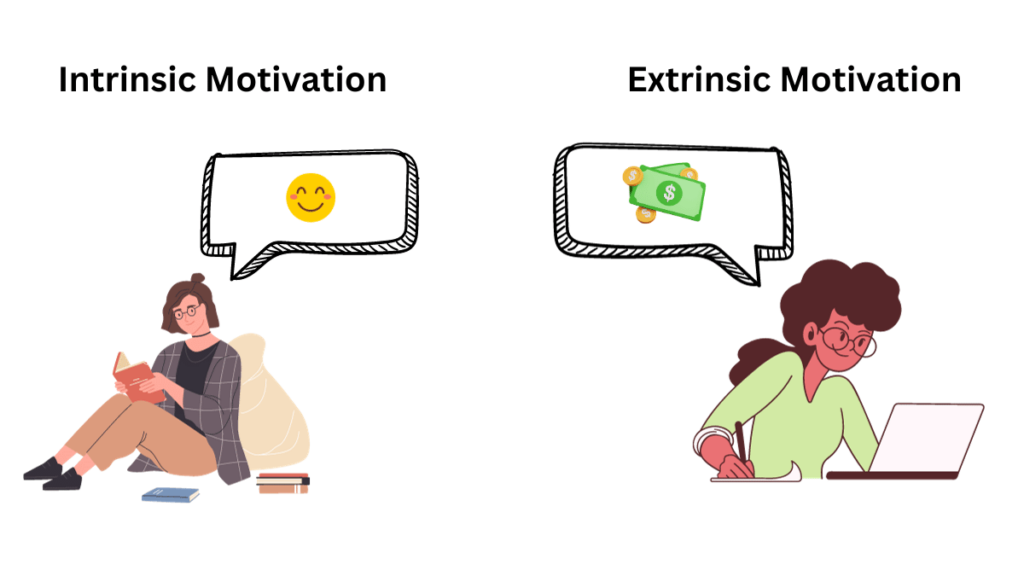Extrinsic vs. Intrinsic Motivation: Key Differences
Extrinsic and intrinsic motivation differ in that extrinsic motivation comes from external rewards, while intrinsic motivation is driven by internal satisfaction. Motivation is crucial in how we behave, perform, and feel. Extrinsic motivation draws upon external factors such as rewards or punishment to drive action, while intrinsic motivation comes from within and involves the internal…

Extrinsic and intrinsic motivation differ in that extrinsic motivation comes from external rewards, while intrinsic motivation is driven by internal satisfaction. Motivation is crucial in how we behave, perform, and feel.
Extrinsic motivation draws upon external factors such as rewards or punishment to drive action, while intrinsic motivation comes from within and involves the internal desire to engage in an activity for its own sake. While extrinsic motivation can temporarily boost motivation, it often results in declining motivation over time. Intrinsic motivation tends to be more enduring and fulfilling.
Understanding the differences between these two forces can help individuals cultivate self-awareness and sustain their motivation and engagement in pursuit of their goals.
Key Takeaways:
- Extrinsic motivation is driven by external rewards like money, recognition, or punishment, offering a temporary boost but often decreasing over time.
- Intrinsic motivation comes from internal satisfaction and personal interest, leading to more lasting and fulfilling engagement.
- While extrinsic motivators can enhance performance short-term, they can also reduce creativity and long-term interest.
- Intrinsic motivation fosters greater persistence, creativity, and well-being but can be hard to maintain without visible progress or external support.
What Is Extrinsic Motivation?
Extrinsic motivation arises from external factors such as rewards or punishment, and it drives individuals to engage in certain behaviors or activities. This kind of motivation is characterized by a focus on external factors, such as financial gain, fame, or the approval of others, rather than on personal interest or enjoyment of the activity itself.
Examples of extrinsic motivation include:
- Receiving a reward or recognition for completing a task
- Meeting a deadline to avoid a penalty or punishment
- Striving for a promotion or raise
- Competing against others for a prize or incentive
- Feeling pressured by external sources like a boss or parent
Although extrinsic motivation can serve as an effective short-term motivator, it may not be as fulfilling or enduring as intrinsic motivation, which is rooted in personal interest and enjoyment.
Benefits of Extrinsic Motivation
Extrinsic motivation can provide numerous benefits, such as increasing productivity and performance. It can also lead to a greater sense of accomplishment and satisfaction, as individuals may feel more incentivized to complete tasks and achieve goals.
Additionally, extrinsic motivation can provide external rewards, such as bonuses or recognition, further enhancing feelings of gratification and drive.
However, it is important to note that intrinsic motivation should also be cultivated, as it is a powerful force for long-term success and personal fulfillment.
Drawbacks of Extrinsic Motivation
Extrinsic motivation has its drawbacks, including the potential for it to become the sole reason for performing a task. When individuals are motivated solely by external rewards, they may become less interested in the task and more focused on the reward. This can lead to decreased creativity, problem-solving ability, and intrinsic motivation.
Extrinsic motivators may not always be available or appropriate. This can then contribute to a lack of motivation without rewards.
Excessive use of external motivators can create a culture of competition and comparison. This can then play a part in causing negative social dynamics and decreased well-being.
What Is Intrinsic Motivation?
Intrinsic motivation refers to an individual’s inner drive and desire to engage in an activity for its sheer enjoyment and satisfaction. In other words, it’s all about doing things for fun and entertainment rather than for external rewards or pressures.
It is characterized by a sense of fulfillment, personal growth, and pleasure from engaging in the activity. Intrinsic motivation often results in better performance, greater persistence, and heightened well-being.
How Intrinsic Motivation Works
Think about some of the things that you enjoy doing. For example, if you happen to enjoy running marathons, what is it that motivates you to compete in these grueling physical challenges?
While extrinsic rewards are present such as trophies, ribbons, and recognition, chances are that the forces motivating you to drag yourself out of bed each morning and tie on your running shoes are intrinsic. You run because the behavior itself is its own reward.
The benefit of intrinsic motivation is that it is typically a much more powerful and enduring force than extrinsic motivation. Many of the activities you engage in on a regular basis are likely driven by such internal rewards.
Hobbies such as gardening, painting, dancing, and crafting all bring enjoyment and happiness to those who participate in them.
This is not to say that intrinsically motivated behaviors are not without rewards. It’s just that these rewards are usually internal.
When you help a friend, volunteer in your community, learn a new skill, or participate in religious activity, you are gaining something inside of yourself that acts as a reward. Feelings of satisfaction, a sense of progress, or the knowledge that you are helping others can help contribute to this sense of intrinsic motivation.
Examples of Intrinsic Motivation
Activities driven by intrinsic motivation include hobbies, creative pursuits, and learning new skills or knowledge for the sheer pleasure of it. Some examples of intrinsic motivation might involve:
- Pursuing a hobby for personal pleasure
- Engaging in a task for the satisfaction of completing it
- Striving to improve oneself for personal growth and development
- Learn something new out of curiosity
- Feeling a sense of pride in one’s work
- Deriving enjoyment from the process of achieving a goal
- Intrinsic motivation is generated from within rather than external rewards or pressures
Factors That Influence Intrinsic Motivation
Over the years, researchers have proposed a number of different theories to explain the factors that contribute to intrinsic motivation. The best-known among these is the self-determination theory put forth by Edward Deci and Richard Ryan.
According to Deci and Ryan’s theory, intrinsic motivation arises from three innate psychological needs:
- A need for competence
- A need to feel independent and autonomous
- A need to feel connected and related to others
In order to feel intrinsically motivated to engage in an activity, whether it involves an academic, athletic, or some other pursuit, people need to feel that the activity is challenging yet achievable and that they have the ability to make choices that will influence the outcome.
When people feel a sense of self-determination along with autonomy and competence, they will feel free to pursue the things that interest them.
In learning situations, these factors can all play a critical role in how motivated students are to study and achieve. If a student perceives the material as too difficult, his or her competence levels will be low. Even with adequate autonomy, the student may feel unmotivated to tackle the material because they see it as simply too difficult or impossible.
It is also important to remember that the balance between competence, autonomy, and relatedness is unique to the individual. What each person finds motivating can vary based on the balance of these influences, other characteristics of the environment, and individual factors.
In other words, what one person finds intrinsically motivating may leave another person feeling demotivated.
Advantages of Intrinsic Motivation
There are numerous benefits associated with intrinsic motivation, including:
- Increased creativity
- Better performance
- Greater sense of satisfaction and fulfillment
When people are intrinsically motivated, they are more likely to take on challenges and pursue their goals with enthusiasm and persistence. This can lead to a sense of mastery and accomplishment, boosting confidence and self-esteem.
Because intrinsic motivation comes from within, it is more resilient to setbacks and failures, allowing us to bounce back from adversity more easily.
Drawbacks of Intrinsic Motivation
One of the drawbacks of intrinsic motivation is that it can be difficult to maintain over a long period of time.
When we are motivated by things that come from within us, such as a desire to learn or a passion for a particular subject, it can be easy to get burned out or lose interest if we don’t see progress or results quickly enough.
Because our own personal interests and desires drive intrinsic motivation, it can be difficult to motivate ourselves to do things that we don’t necessarily enjoy or find interesting.
This can be a challenge in situations where we need to complete necessary but not particularly enjoyable tasks, such as studying for exams or doing household chores.
Intrinsic motivation is primarily self-driven. This means that getting feedback or support from others is sometimes difficult. This not only makes it more difficult to stay motivated; it also makes it harder to get constructive criticism that can help you hone your skills.
Comparing Extrinsic and Intrinsic Motivation

Extrinsic motivation is driven by external rewards such as money, grades, or praise from others. On the other hand, intrinsic motivation comes from within and is driven by personal satisfaction, enjoyment, and a sense of accomplishment.
While extrinsic motivation can be effective in the short term, relying solely on external rewards can lead to a lack of motivation when the rewards are no longer present. Intrinsic motivation is a more sustainable and fulfilling form of motivation driven by personal values and goals.
Impact on Behavior
| Extrinsic motivation | Intrinsic motivation |
| Can be effective in the short term as it provides immediate gratification | Associated with higher levels of well-being and performance |
| Can lead to a decrease in motivation and performance | Creates a sense of purpose and satisfaction |
| May lead to a poor sense of control | Associated with greater autonomy and control |
| Focus on rewards/punishment decreases interest and engagement | Contributes to increased engagement, creativity, and productivity |
| Can be helpful with repetitive, routine tasks | Can be helpful with creative, innovative tasks |
While extrinsic motivation can be effective in certain circumstances, intrinsic motivation is associated with greater well-being and performance in the long term. It is important to consider both types of motivation when designing motivational strategies to ensure that individuals are engaged, motivated, and performing at their best.
While extrinsic and intrinsic motivation are often presented as highly distinct forces, researchers note that they are connected and often interact. Sometimes external rewards can boost internal motivation. In other cases, extrinsic motivators can reduce a person’s internal drive to do something.
For example, one meta-analysis found that both extrinsic and intrinsic incentives are responsible for predicting performance.
External Rewards Complicate Intrinsic Motivation
Researchers have found that offering extrinsic rewards for behaviors that people already find internally motivating can actually reduce intrinsic motivation. This tendency is known as the overjustification effect.
In one classic experiment, researchers found that when kids were given extrinsic rewards for playing with a toy that they already found intrinsically motivating, their motivation to engage in the activity actually decreased.
Such findings have important implications for school settings, where children are often encouraged to pursue tasks to gain rewards. The fear for educators is that, in some cases, rewarding kids might actually hurt their internal drive to learn.
Conditions of the Reward Matter
In research by Deci, intrinsic motivation was found to decrease when external rewards were dependent upon completing a task, such as getting a dollar for every puzzle solved.
Motivation was unaffected, however, when rewards were not linked to task completion, such as getting rewarded for showing up.
Expectations Also Play a Role
Lepper and colleagues found that expectations of rewards can also play a role in how motivation is affected by external rewards. When students expected some type of extrinsic reward for participating in an activity, their motivation levels were more likely to decrease as a result.
When rewards were unexpected, there was no effect on intrinsic motivation levels.
Why Do Extrinsic Rewards Impact Intrinsic Motivation?
So why do external rewards sometimes have an effect on motivation? Because, like other variables that can affect patient levels, our words can convey important information about factors such as autonomy and competence.
External rewards can cause students to sometimes feel that they’re being pressured into doing something they don’t want to do, essentially depriving them of their independence.
These rewards can also make students feel as though they are doing something that they are not really capable of doing. Instead of doing a task because they feel competent and engaged, they are doing it simply to earn a reward. This does not lend itself to feelings of competence.
When people feel that they have lost their independence and confidence in a situation due to the presence of an external reward, their levels of intrinsic motivation may be affected.
Applications for Extrinsic vs. Intrinsic Motivation
Extrinsic and intrinsic motivation play important roles in contexts such as school and work.
Extrinsic vs. Intrinsic Motivation in Academics
In school, extrinsic motivation can take the form of grades, rewards, and praise from teachers and parents.
While extrinsic motivators can encourage students to engage in certain behaviors or activities, they may not necessarily lead to a deeper understanding of the material or long-term interest in the subject.
In contrast, intrinsic motivation can result in a greater enjoyment of learning, a deeper understanding of the material, and a stronger sense of personal growth and development.
Extrinsic vs. Intrinsic Motivation at Work
Similarly, in the workplace, extrinsic motivators can take the form of salary, promotions, and bonuses. While these external factors can encourage employees to perform well, they may not necessarily result in job satisfaction or a sense of fulfillment.
On the other hand, intrinsic motivation can result in a stronger commitment to the job, better performance, and a greater sense of personal satisfaction and well-being.
A balance of both extrinsic and intrinsic motivation can be beneficial in both school and work contexts.
Enhancing Extrinsic vs. Intrinsic Motivation
There are several strategies that can be used to enhance extrinsic motivation.
- Offer rewards or incentives for completing certain tasks or achieving specific goals. This can include bonuses, promotions, or other types of recognition.
- Create a sense of competition among employees or team members, which can help to motivate people to work harder and achieve better results.
- Provide regular feedback and coaching. This can help keep people motivated and engaged and provide opportunities for learning and growth.
- Create a positive work environment and culture. This can also help to enhance extrinsic motivation by fostering a sense of community and teamwork and promoting a shared sense of purpose and vision.
By using these strategies, organizations can help to motivate their employees and achieve better results.
Several effective strategies can help enhance intrinsic motivation:
- Set achievable goals that align with personal interests and values. When individuals clearly understand what they want to accomplish and why it matters to them, they are more likely to feel motivated to succeed.
- Provide opportunities for autonomy and self-direction. This might involve giving individuals more control over their work or allowing them to choose how they approach a task.
- Foster a sense of competence and mastery. This can be achieved by providing constructive feedback, acknowledging progress, and celebrating successes along the way.
By incorporating these strategies, individuals can cultivate a strong sense of internal motivation and drive to help them achieve their goals with greater ease and satisfaction.
Summary
Extrinsic motivation is the kind of motivation that arises from external factors such as rewards or punishment, while intrinsic motivation comes from within oneself and is driven by personal interest and enjoyment. Extrinsic motivation can provide a short-term boost to motivation, but it often decreases motivation over time.
Conversely, intrinsic motivation is more sustainable, leading to better performance, greater persistence, and a stronger sense of well-being and personal growth. Understanding the differences between these two types of motivation can help individuals better understand their own motivation and find ways to stay motivated and engaged in their goals.
Sources:
Cerasoli CP, Nicklin JM, Ford MT. Intrinsic motivation and extrinsic incentives jointly predict performance: a 40-year meta-analysis. Psychol Bull. 2014;140(4):980-1008. doi:10.1037/a0035661
Morris LS, Grehl MM, Rutter SB, Mehta M, Westwater ML. On what motivates us: a detailed review of intrinsic v. extrinsic motivation. Psychol Med. 2022;52(10):1801-1816. doi:10.1017/S0033291722001611
Ramirez-Andreotta MD, Tapper A, Clough D, Carrera JS, Sandhaus S. Understanding the intrinsic and extrinsic motivations associated with community gardening to improve environmental public health prevention and intervention. Int J Environ Res Public Health. 2019;16(3):494. doi:10.3390/ijerph16030494




